A modern and future-oriented style, high-tech in landscape design blends minimalism with futuristic ideas and dreams of space, impressing with its extravagance, fresh ideas, and practicality. It remarkably combines simplicity of form with luxurious content, external restraint with internal expression, visual statics with continuous dynamics. Harmonious and self-sufficient, high-tech in landscape design resembles a stylish studio apartment under the open sky.
Conceptual Features of High-Tech Style in Landscape Design
Innovation and technology are the key parameters of high-tech style in landscape design. High-tech style embraces experimentation, always staying open to cutting-edge developments. Its conceptual features shine through not just in the choice of forms and materials, but also in the design and execution of engineering and construction ideas. Here’s a summary of these characteristic features:
- maximum freedom of space;
- demonstrative urbanity;
- use of optical illusions;
- distinct geometry of lines and contours;
- boldly expressed pathways and steps;
- rhythmic and visually dynamic overall landscape;
- abundance of landscape lighting;
- absence of strict symmetry;
- use of perennials with dense foliage or low-growing conifers in decoration;
- vertical greenery for masking fences;
- futuristic figures and stones as decor.
Layout and Zoning
One of the advantageous features of high-tech style in landscape design is its flexibility to the terrain of the site. By skillfully incorporating all the irregularities and avoiding obvious internal barriers, it always demonstrates the integrity of the composition and thematic connection of each element.

Usually, the layout lacks symmetry but reveals a strong preference for geometry in all its elements. The lines are straight, the contours are sharp, and the angles are right. From the planning phase, the design emphasizes ample light and open space. As a part of this approach, a significant portion of the area is allocated to lawns, mirror-like ponds, and plain areas paved with concrete or tiles.
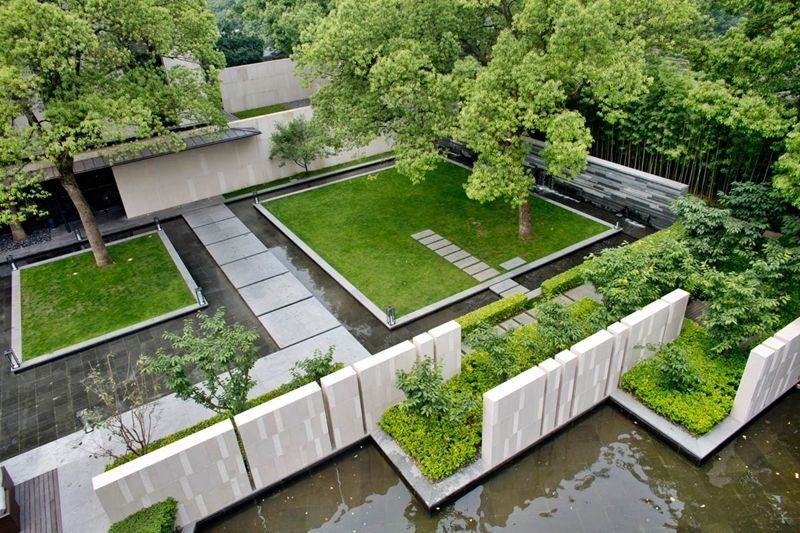
The zoning in high-tech landscaping is predominantly symbolic in nature. Dividing elements such as gabions or carefully trimmed hedges are intended to emphasize the integrity of the composition rather than isolate any particular part of it.
Materials and Colors
High-tech is a style that requires the use of the most modern materials to realize its design ideas. Given its minimalist roots, the priority materials are metal, glass, and plastic. Mirrored elements are essential for creating special optical effects, while gravel or pebbles are used for filling the free space between thematic fragments.
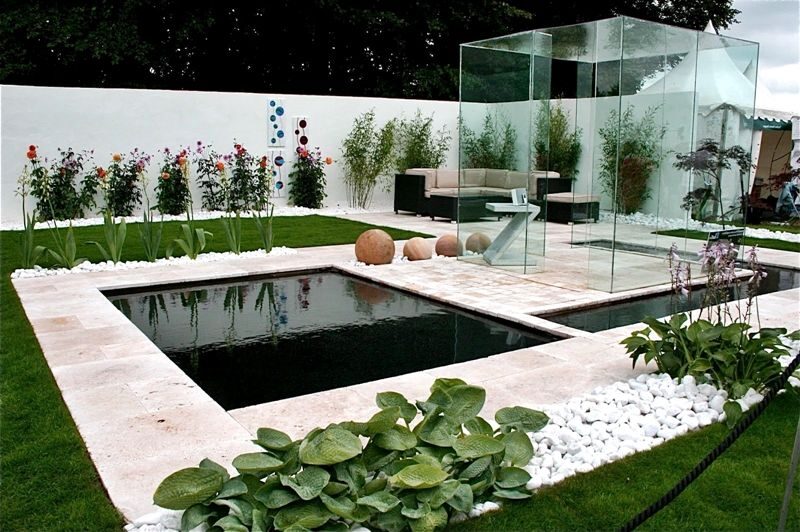
The preferred coverings include concrete, large tiles, and polymer wood.
The decorative design involves the use of natural polished stone or an impressive artificial equivalent. Ceramic is also appropriate in the form of original but extremely concise plant containers.
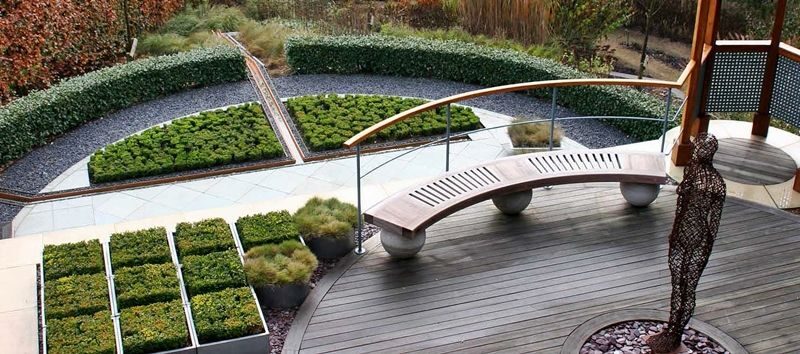
High-tech style showcases a fairly subdued color palette, focusing on neutral tones like light gray, beige, and white. The natural greenery of plants and lawns emphasizes the technological ambiance, while metallic decorative elements with unusual lighting in shades of purple, burgundy, and blue serve as accents.
Pathways, Lawns, and Areas
As for pathways, lawns, and areas, high-tech style features maximum surface smoothness and distinct contour clarity. Often, the materials used are concrete, arboform, or ceramic granite. Additionally, the decoration of these areas can include remarkable geometric inlays crafted from polished wood or metal.
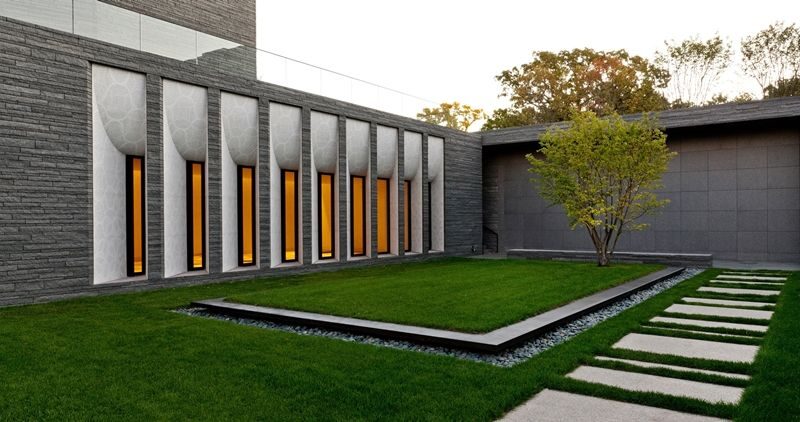
You should decorate any sports areas with artificial grass or seamless rubber flooring.
In high-tech landscaping, lawns should always appear green and impeccably trimmed. If you want, you can replace the natural turf with a gravel covering, which greatly simplifies the maintenance of the area.
Small Architectural Forms
When it comes to small architectural forms in high-tech landscaping, gazebos, pergolas, and garden benches are the most common. This design style is characterized by a wealth of the latest achievements, so all these structures inevitably have a non-standard, original shape. These designs leave a lasting impression and are an integral part of the decorative design. All structures in the high-tech style are unique and incorporate both static and dynamic elements.

Symbolic spheres, cubic structures, and other futuristic or avant-garde products made of stone, metal, glass, or ceramic are widely used as decorative elements. Authentic handcrafted sculptures by authors are also in demand in this style.
Garden Furniture
Garden furniture in accordance with the high-tech concepts should make an impression. Uniqueness can be expressed both in shape and in the material from which it is made. Typically, it includes glass, plastic, stone, and wooden elements. Devoid of fancy decoration, these items attract attention with their originality and unexpected combination of components.
Water Features
Despite its technological focus, high-tech design is very sensitive to water. A high-tech style landscape is simply unthinkable without artificial water features. In line with the style’s concepts, the distinctive features of these features include:
- Precise geometric shape
- Concrete, glass or metallic framing
- Lighting features
- Absence of vegetation.
In limited space conditions, it is possible to use modular ponds with raised edges above the ground.
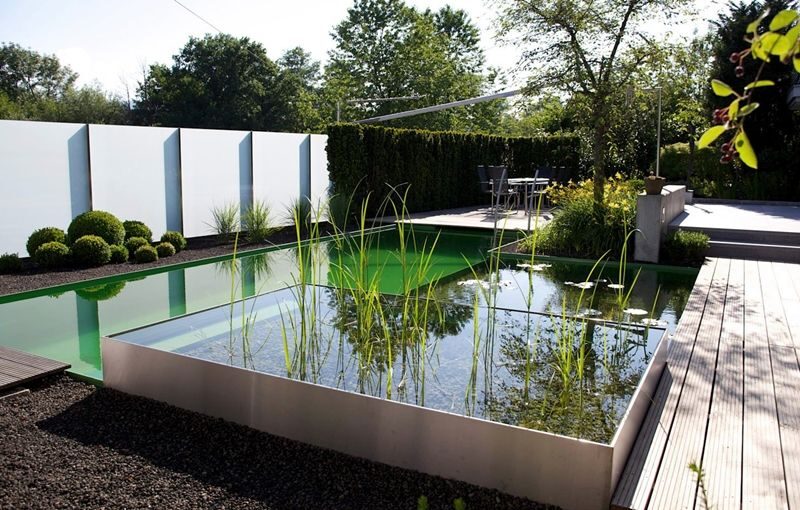
For more spacious areas, water systems that cover the entire plot and consist of a composition of ponds and pools of various sizes are suitable. They can be located separately from each other or connected by symbolic canals.
A stylish fountain in the high-tech style on the plot is a structure in the form of an abstract or precisely geometric figure made of glass, stone or metal.
Lighting
Highlighting the futuristic and originality of the high-tech style in landscape design is accomplished through lighting. Each lighting fixture plays its own individual role, either providing functional lighting or creating the necessary visual effect. As a rule, on the plot, each significant element has its own lighting, often in color.
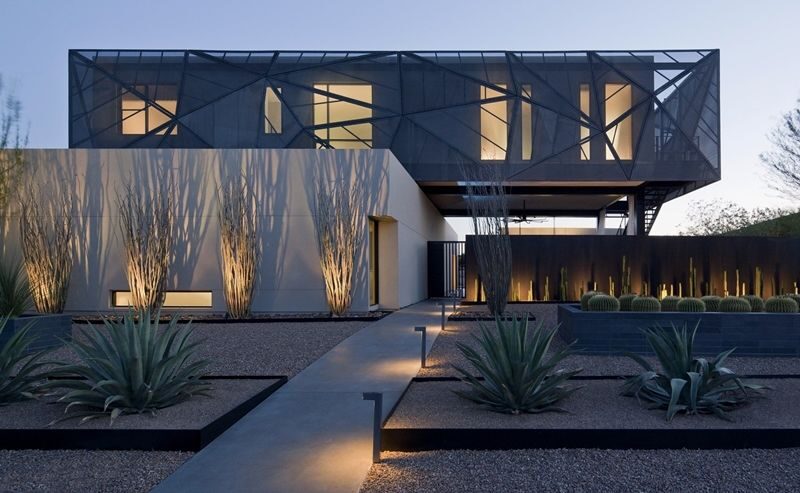
The lighting fixtures and lighting systems themselves must be in keeping with the spirit of the times, being both convenient to use and original in design. LED lanterns and solar-powered options are still relevant.
You can use optical illusions to emphasize the unique, high-tech nature of the site and its connection to a “space” theme. All you need is the right placement of reflective fragments and lighting fixtures.
Plants
Regarding plants, the high-tech style’s industrial and futuristic character typically excludes an abundance of greenery. Use plants sparingly and only where necessary in such a design scheme.
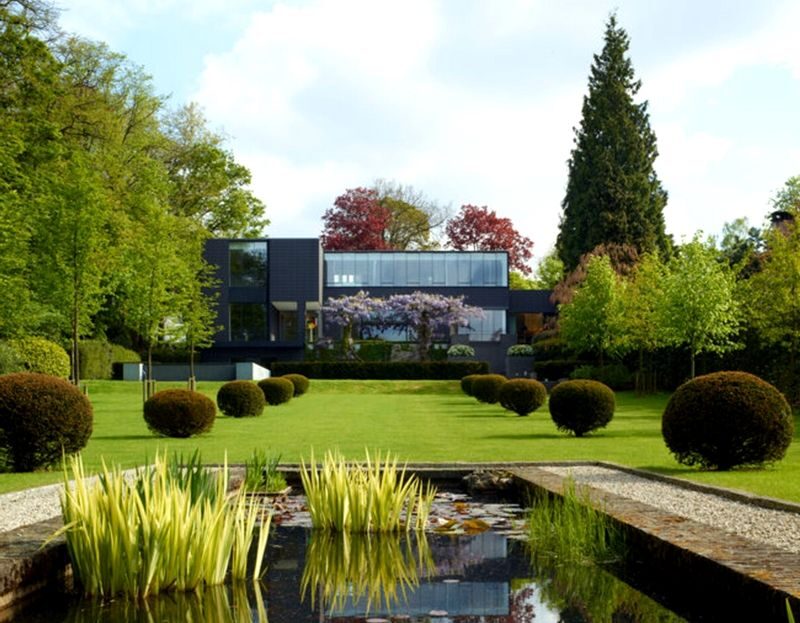
Monochrome plantings dominate symbolic flower beds, lawns, and the perimeter of the space, showcasing the unique shape of the plant’s crown or foliage. Suitable plants for this kind of landscaping include hostas, ferns, heucheras, and decorative grasses. Surround the flower beds with simple borders made from concrete, stone, or plastic for a clean and orderly appearance.
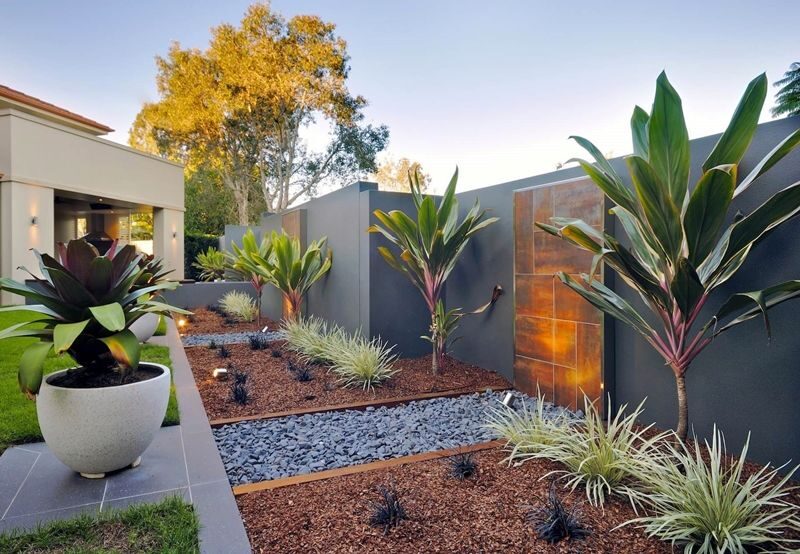
Among trees, preference is given to those with clear outlines of the crown: conifers, maples, and decorative apple trees.
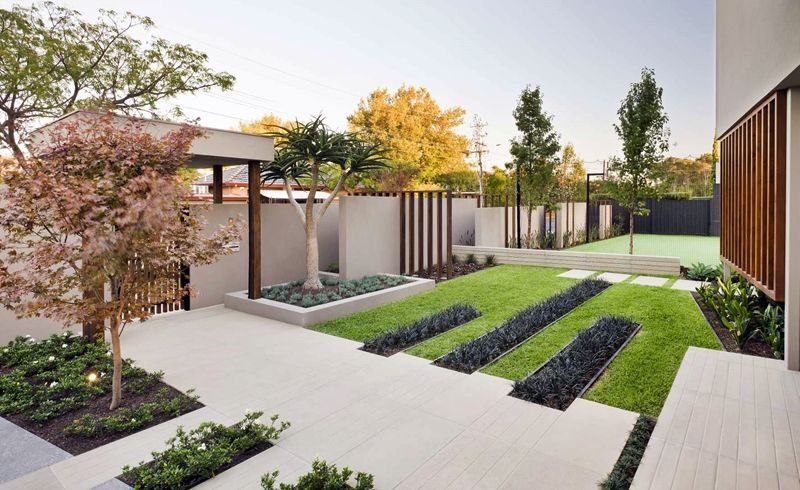
Despite the clear austerity in plant design, dendroplastics has gained popularity in this ultra-modern style, enabling the creation of voluminous compositions from shrubs planted in limited spaces. The density of the interlocking crowns of plants of varying heights allows for compositions that create the impression of a voluminous object, equatable to small architectural forms. The plant components used for these purposes include:
- Juniperus virginiana
- Spiraea
- Cotoneaster
- Physocarpus
- Symphoricarpos
- Cornus alba.
In high-tech landscape design, plants in containers are also used. Made of concrete, metal, or plastic, the planting containers can have various geometric shapes and sizes that correspond to the overall parameters of the site.
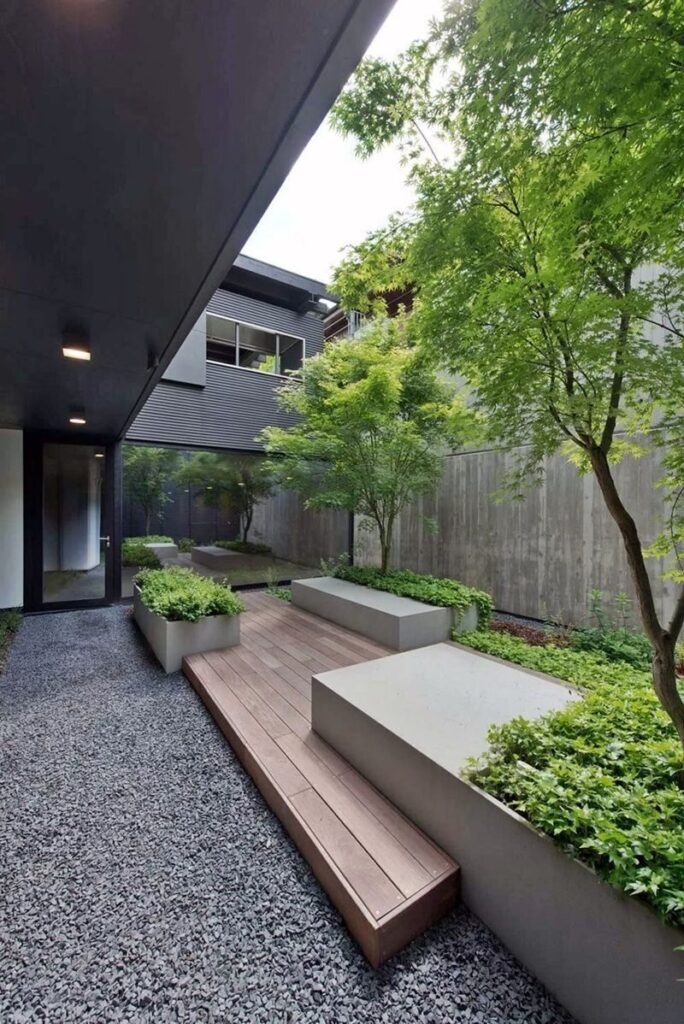
To camouflage walls, fences, and borders of properties, vertical landscaping is sometimes used in high-tech landscape design. For this purpose, vines such as Virginia creeper, ivy, and kiwi are used.
Fences and Enclosures
Fences and barriers in a high-tech style landscape are only appropriate around the perimeter of the property for seclusion from the outside world. An optimal solution for such purposes would be a system consisting of alternating sections of gabions with original fillings and polycarbonate or metal sheets. Fences made of terrace boards, placed both vertically and horizontally, are also in high demand.
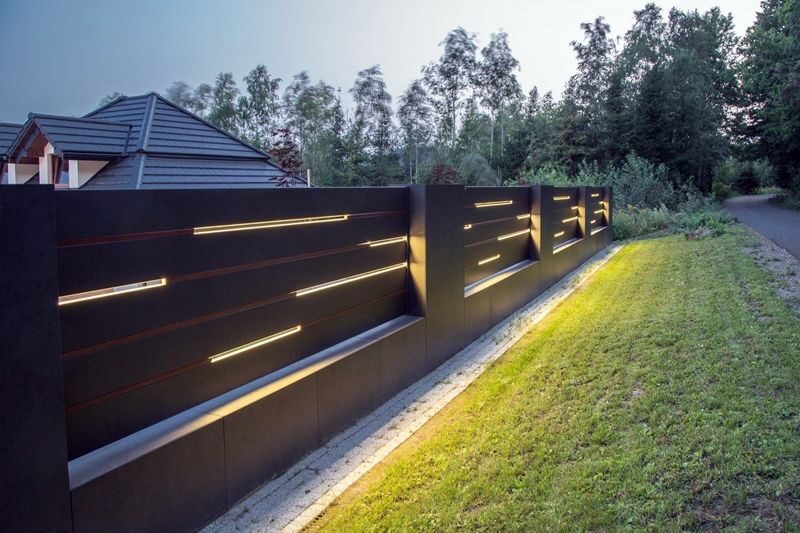
Sometimes, to provide a natural screen and create a suitable backdrop, tall plants line the fence, or vertical gardening techniques are applied. This helps to integrate the fence seamlessly into the landscape while enhancing the beauty and privacy of the outdoor space.

Inside the plot, a low and carefully trimmed live hedge that resembles a border can serve as a symbolic fence.
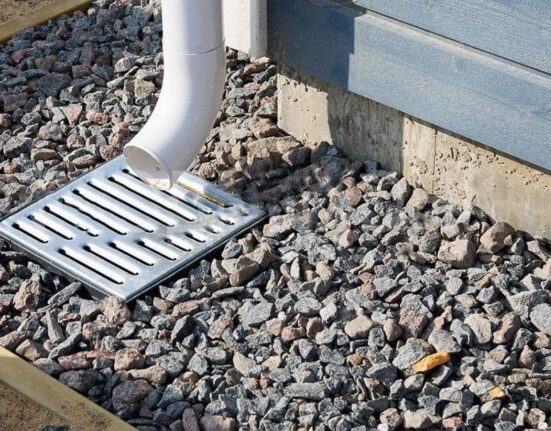
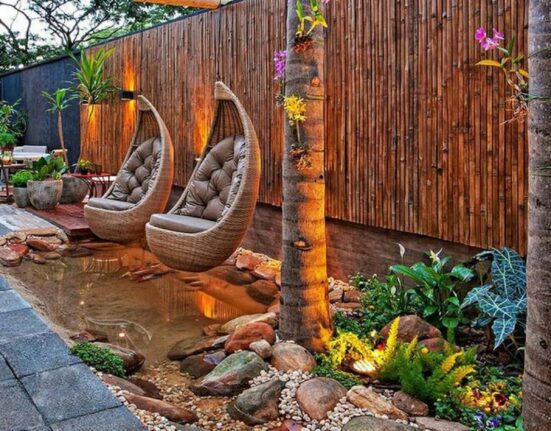


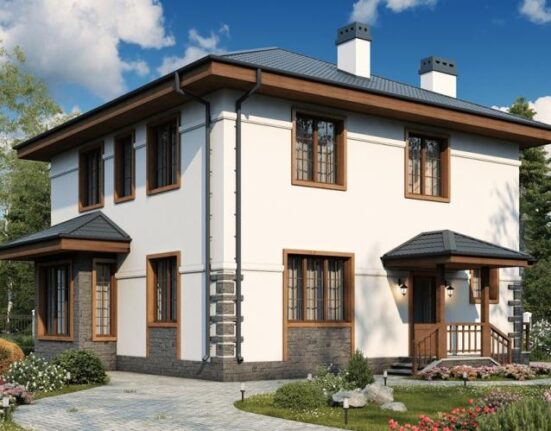

Leave feedback about this